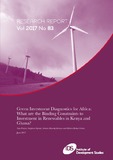Green Investment Diagnostics for Africa: What are the Binding Constraints to Investment in Renewables in Kenya and Ghana?
| dc.contributor.author | Pueyo, Ana | |
| dc.contributor.author | Spratt, Stephen | |
| dc.contributor.author | Bawakyillenuo, Simon | |
| dc.contributor.author | Hoka Osiolo, Helen | |
| dc.coverage.spatial | Kenya | en |
| dc.coverage.spatial | Ghana | en |
| dc.date.accessioned | 2017-06-08T08:08:24Z | |
| dc.date.available | 2017-06-08T08:08:24Z | |
| dc.date.issued | 2017-06-07 | |
| dc.identifier.citation | Pueyo, A., Spratt, S., Bawakyillenuo, S. and Hoka Osiolo, H. (2017) Green Investment Diagnostics for Africa: What are the Binding Constraints to Investment in Renewables in Kenya and Ghana? IDs Research Report 83. Brighton: IDS. | en |
| dc.identifier.isbn | 978 1 78118 362 5 | |
| dc.identifier.uri | https://opendocs.ids.ac.uk/opendocs/handle/20.500.12413/12999 | |
| dc.description.abstract | The vast potential of renewable energy is failing to be realised in many African countries, in spite of the many pledges made by donors and international financiers. This is not due to a lack of policies supporting investment. Many African countries have renewable energy targets, feed-in-tariffs (FiT), or import duty exemptions for renewable energy technologies. In some cases these policies are not fully implemented. In others they are implemented but, put in the language of this report, they are not targeting the most binding constraints to investment. Whatever the reason for their lack of success, it is clear that simply introducing formal policies is not enough. This Research Report presents the Green Investment Diagnostics methodology that aims at supporting policymakers to better target policies for the promotion of renewable energy investment. Our approach draws from the original Growth Diagnostics developed by Hausmann, Rodrik and Velasco (2004) to identify the most binding constraints to economic growth in developing countries. We adapt that approach to the particular case of the energy sector, so that we can identify the main bottlenecks faced by renewable energy investors in a particular country. We start by asking: for this particular country, at this particular time, what is preventing higher levels of investment in renewable energy generation technologies for which there is an economic rationale? To answer this question we follow a systematic approach, which starts with a decision tree analysis and continues with the cumulative building of evidence to back up potentially binding constraints. We apply the new methodology to two Sub-Saharan African countries, Kenya and Ghana, but this exercise could be replicated in any other context. In Ghana, we look for the reasons for underinvestment in renewable generation capacity. We find that renewable energy investments provide low returns in the country, disproportionate with the very high risks coming from an unreliable off‑taker, poor regulation, macroeconomic imbalances and corruption. Furthermore, there is insufficient access to finance due to scarce domestic finance and high returns expectation for short-term loans. In Kenya, we first look for factors behind the successful attraction of investment for large-scale renewables, mainly wind and geothermal. We then focus on the constraints to future investment, particularly in flexible, smaller-scale technologies more appropriate for increasing electrification rates in rural areas. Kenya offers generous returns to investment in renewables and least cost generation from geothermal and wind. However, it faces high system costs due to a lack of networking infrastructure and an inflexible generation mix. It also presents regulatory constraints at the planning and procurement stages and serious problems of social acceptance. Social problems are exacerbated by uncertain land property rights and consultation processes, inequality in access to services, and the rent-seeking behaviour of local elites. At the heart of each country’s constraints there is a stable status quo in each country: the over-borrowing state in Ghana, and a rent-capturing elite in Kenya. | en |
| dc.language.iso | en | en |
| dc.publisher | Institute of Development Studies | en |
| dc.relation.ispartofseries | IDS Research Report;83 | |
| dc.rights | This is an Open Access report distributed under the terms of the Creative Commons Attribution 4.0 International licence, which permits unrestricted use, distribution, and reproduction in any medium, provided the original authors and source are credited. https://creativecommons.org/licenses/by/4.0/legalcode | en |
| dc.rights.uri | http://creativecommons.org/licenses/by/4.0/ | en |
| dc.subject | Trade | en |
| dc.title | Green Investment Diagnostics for Africa: What are the Binding Constraints to Investment in Renewables in Kenya and Ghana? | en |
| dc.type | IDS Research Report | en |
| dc.rights.holder | Institute of Development Studies | en |
| dc.identifier.team | Green Transformations | en |
| rioxxterms.funder | Default funder | en |
| rioxxterms.identifier.project | Default project | en |
| rioxxterms.version | VoR | en |
| rioxxterms.funder.project | c941507f-fd0b-4fc3-9822-4b2132f61a1d | en |
Files in this item
This item appears in the following Collection(s)
-
IDS Research [1671]
Except where otherwise noted, this item's license is described as This is an Open Access report distributed under the terms of the Creative Commons Attribution 4.0 International licence, which permits unrestricted use, distribution, and reproduction in any medium, provided the original authors and source are credited. https://creativecommons.org/licenses/by/4.0/legalcode


